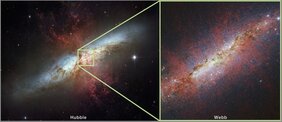Astrophysicists from Heidelberg University will use data obtained by the James Webb Space Telescope of the remarkable galaxy Messier 82 to test their state-of-the-art models of the formation of new stars under extreme environmental conditions. The observations and their analysis have been accepted for publication in the "Astrophysical Journal".
A team of astronomers including the astrophysicists Ralf Klessen and Simon Glover from Heidelberg University has used NASA’s James Webb Space Telescope to survey the "starburst galaxy" Messier 82 (M82). In this remarkable galaxy, 12 million light-years away, new stars are born 10 times faster than in the Milky Way galaxy. Therefore, it is considered to be a proxy for studying the formation of new stars under extreme environmental conditions.
Led by Alberto Bolatto at the University of Maryland, College Park, the science team directed Webb’s NIRCam (Near-Infrared Camera) instrument towards the starburst galaxy’s centre to study the physical conditions that foster the formation of its new stars.
Ralf Klessen, co-author of the science paper and expert for theoretical foundations and the numerical simulation of star formation, is excited about the new data. "The processes in M82 are extremely complex but that is precisely why this object is an ideal application case for our theoretical-numerical predictions and thus our understanding of the underlying physical processes," he said.
Star formation usually is difficult to observe because it is shrouded by curtains of dust and gas. But Webb’s ability to peek through these curtains in the infrared at high angular resolution is an asset in navigating these murky conditions.
Prof. Dr Klessen and his research group at the Institute for Theoretical Astrophyics, which is part of the Centre for Astronomy of Heidelberg University (ZAH), play a leading international role in developing a theory of star formation based on the interplay between interstellar turbulence and gravity. Their approach is of high predictive power and remarkably successful in explaining the birth of stars in the complex multi-phase interstellar medium. "These new and excellent data will allow us to test our models or - vise versa - we will predict what we see in the infrared and compare our results with Webb's observations," Klessen resumes.
What one sees on Webb's images are dark brown tendrils of heavy dust threaded throughout M82’s glowing core and extending above and below the galaxy’s plane. These are signs of a "galactic wind" rushing out from the core of the starburst. Understanding how this galactic wind, which is caused by the rapid rate of star formation and subsequent supernovae in combination with the presence of magnetic fields and cosmic rays, is being launched and influencing its surrounding environment is one area of focus for the research team. Webb was able to reveal the wind's fine structure via emission from chemical molecules known as polycyclic aromatic hydrocarbons (PAHs). PAHs can be considered as very small dust grains that survive in cooler temperatures but are destroyed in hot conditions.
Depicted in the image as red filaments, the PAH emission extends away from the central region where the heart of star formation is located and unexpectedly resembles in structure the emission and of hot, ionized gas. This was surprising because PAHs are not supposed to live very long when exposed to a strong radiation field and challenges our theories of star formation. At the same time it is a new asset which Ralf Klessen's research team will consider in their numerical modelling of the underlying processees.
The science team will in the near future also have spectroscopic observations of M82 from Webb ready for their analysis, as well as complementary large-scale images of the galaxy and wind. These data will provide a sense of timing for how long each phase of star formation lasts in a starburst galaxy environment and help star formation theories to finetune their models.
ABOUT THE JAMES WEBB SPACE TELESCOPE (WEBB)
Webb is the world’s premier space science observatory, solving mysteries in our solar system, looking beyond to distant worlds around other stars, and probing the mysterious structures and origins of our universe and our place in it. Webb is an international program led by NASA with its partners, ESA (European Space Agency) and the Canadian Space Agency. See also webb.nasa.gov
ADDITIONAL INFORMATION
esa-webb press release
Ralf Klessen Research Group
Centre for Astronomy of Heidelberg University (ZAH)
SCIENTIFIC CONTACT
Prof. Dr. Ralf Klessen
Centre for Astronomy of Heidelberg University (ZAH)
Institute for Theoretical Astrophysics (ITA)
klessen@uni-heidelberg.de
LOCAL CONTACT FOR THE MEDIA
Dr. Guido Thimm
Centre for Astronomy of Heidelberg University (ZAH)
thimm@uni-heidelberg.de

